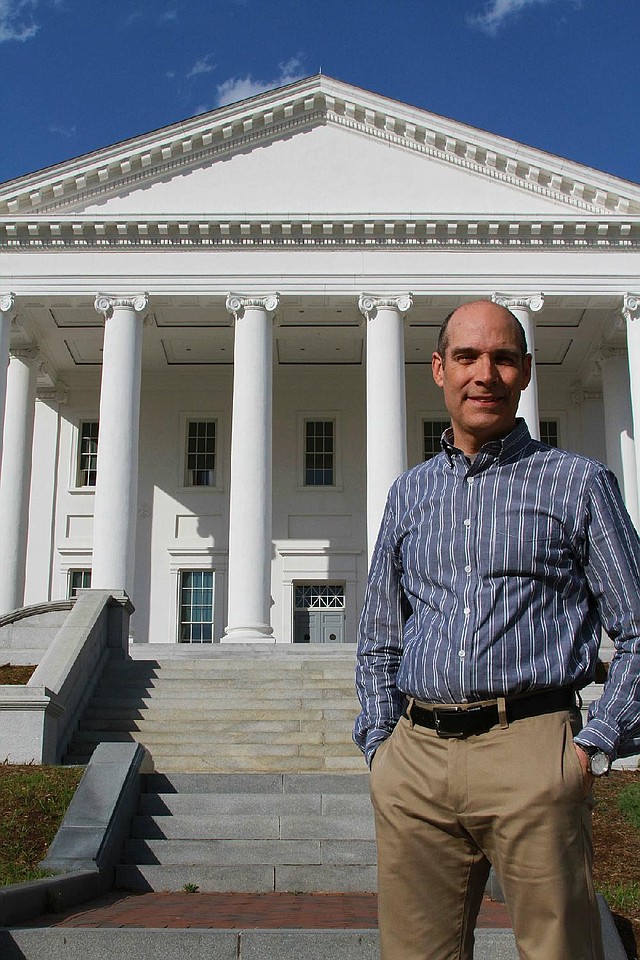PBS looks at 10 Buildings That Changed America
Host Geoffrey Baer stands before the Thomas Jefferson-designed state Capitol in Richmond, Va. It’s just one of the structures highlighted in PBS’ 10 Buildings That Changed America.
Sunday, May 12, 2013
For many, architecture (like art) comes to mind only when a structure tends to cause controversy.
Remember the stink when critics said the “Bridge to the Future” Clinton Presidential Center looked like a giant double-wide trailer or beached aircraft carrier? Taste may be highly subjective, but I think the place, designed by Jim Polshek of Polshek Partnership Architects in New York, is stunning. It’s a visual treat inside and out.
Others agree. The building, which opened in 2004, received a prestigious 2006 Institute Honor Award for Architecture from the American Institute of Architects.
With historic (and sometimes controversial) architecture in mind, PBS has a new special that even the layman should find interesting.
10 Buildings That Changed America airs at 10 p.m. today on AETN. It highlights buildings that “changed how we live, work and play.”
Take a look at the photo with today’s column. That’s the special’s host, Geoffrey Baer, standing in front of the state Capitol in Richmond, Va. It looks like a larger Old State House in Little Rock. There’s a good reason for that.
The Virginia Capitol was designed by Thomas Jefferson and built in 1788. It marked the beginning of the American tradition of modeling government buildings on Roman and Greek temples.
Arkansas’ Old State House was begun in 1833 in the Greek Revival style and pronounced finished in 1842, although tinkering took many more years. There may not have been much here in our freshly minted state, but we had us a fancy Capitol building.
The special was shot on location from Massachusetts to Los Angeles, “and features rare archival images, distinctive animation, and interviews with some of the nation’s most insightful historians and architects, including Frank Gehry and Robert Venturi.”
Evidently, those two are big guns in the architect business.
The Emmy-winning Baer, best known for his specials about Chicago architecture and history, says, “You may not have heard of all of these 10 buildings, but their influence is all around you. There’s a good chance that these revolutionary works of architecture inspired your local city hall or library, the mall where you shop, the office building or factory where you work, and maybe even your own house.”
10 Buildings That Changed America takes viewers inside these groundbreaking buildings to reveal “the shocking, funny and even sad” tales of how they came to be.
From Boston’s Trinity Church, designed as “an envelope” for the voice of the Rev. Phillips Brooks (best known today as the lyricist of “O Little Town of Bethlehem”), to the Highland Park Ford Plant in Michigan, designed by Jewish architect Albert Kahn, the program explores how their construction had consequences - some unintended - on cities and communities across the country.
Ultimately, the special is a trip inside the imaginations of a group of architects who dared to create these influential structures. None, I suspect, were criticized for constructing a giant double-wide trailer, but there were comparable complaints.
Here are the 10 highlighted buildings:
Virginia state Capitol, Richmond, Va. (1788) - It started the trend.
Trinity Church, Boston (1877) - Created by architect H.H. Richardson, Trinity was the first example of Richardsonian Romanesque style, which was later used in churches, city halls and county courthouses across America.
Wainwright Building, St. Louis (1891) - Louis Sullivan’s creation was not the first skyscraper, but it gave the modern, steel-frame skyscraper its form.
Robie House, Chicago (1910) - Frank Lloyd Wright’s prairie style transformed the American home and even inspired the ranch houses of the mid-20th century.
Highland Park Ford Plant, Highland Park, Mich. (1910) - The first home of Henry Ford’s moving assembly line, Kahn’s “daylight factory” design revolutionized industrial architecture.
Southdale Center, Edina, Minn. (1956) - Architect Victor Gruen gave America its first fully enclosed, indoor regional shopping mall.
Seagram Building, New York (1958) - Mies van der Rohe’s tower on Park Avenue was the model for modernist skyscrapers built across the country in the mid-20th century: a dark glass box, set back on an open plaza.
Dulles International Airport, Chantilly, Va. (1962) - Designed by Eero Saarinen, this was the first airport in the world created especially for jets.
Vanna Venturi House, Philadelphia (1964) - In an age of austere glass boxes, Venturi dared to design a postmodern home that looked like a child’s typical drawing of a house.
Walt Disney Concert Hall, Los Angeles (2003) - Gehry’s swooping stainless steel design was a radical departure from the traditional, stuffy idea of a concert hall. The TV Column appears Sunday, Tuesday and Thursday. E-mail:
Style, Pages 50 on 05/12/2013
